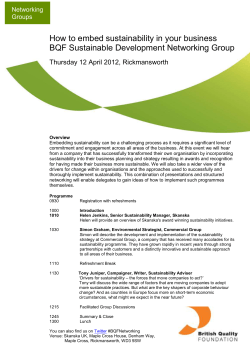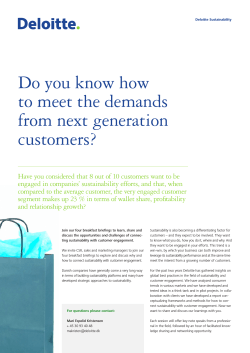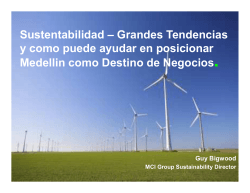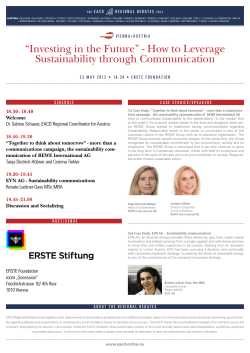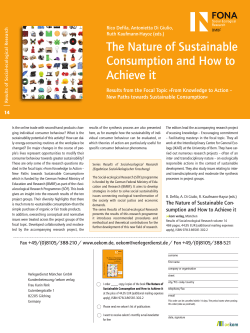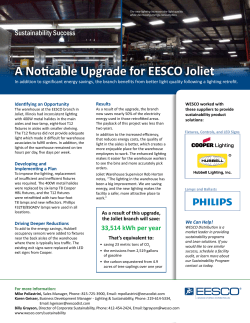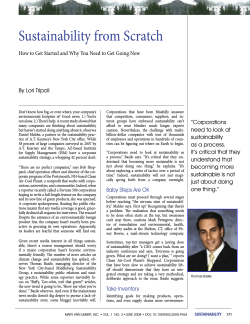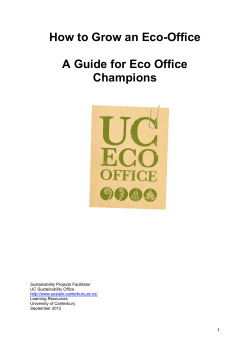
“The Sustainability Report Card: How to Avoid Washing” Green
“The Sustainability Report Card:
How to Avoid GreenWashing”
Jacqueline Kuehnel
JK Consulting Enterprises
Toronto , Canada
1
Key objectives
Setting the stage
• Greenwashing definitions and
how they fit into sustainability
communication (in other words,
the gray area of greenwashing)
• Codes of ethic and codes of
conduct ( the intersection
between compliance and doing
the right thing)
Why communicate Sustainability
• Internal and external
stakeholders
• Benefits (if done right)
The greenwash trap
• Causes and consequences
(intended and unintended)
Types of greenwash
• Ten types of greewash and seven
sins
Prevention
• Accuracy, substantiation and
verifiability
Sustainability Reporting
• Steps to create a report, do,
don'ts and challenges
2
Greenwashing – definition and perception
“Disinformation disseminated
by an organization so as to
present an environmentally
responsible public image”.
Oxford English Dictionary
“When green-talk and green
practice are promoted by
fundamentally
unsustainable companies or
other uncaring institutions,
they easily congeal into a
deceptive ideology known
as “greewashing”.
Greer J, and Bruno K. Greenwash: The Reality Behind
Corporate Environmentalism. Apex Press, New
York, 1997.
3
GREEN vs.. Sustainability
A Typology of Differences
DIMENSIONS
Relation to the
sustainability
tripod
GREEN
Only one leg ( environmental
improvemenet)
SUSTAINABLE
All three legs (environmental health,
economy vitality, social Justice)
Tactical application of activities that
involve "picking low hanging fruit",
Tacticts / Strategy promoting individual changes and
reforms to make the world less
unsustainable
Interplay of individual components
and whole system
Strategy discovery of the proper scale
that will make successive policy steps
and actions easier and less costly by
designing and implementing a
sustainable self-balancing system
Political
orientation
Conventional, "pragmatic realist,
reformist
Innovative visionary, revolutionary
("going to the roots")
Scale
Individual devices, products,
indicators, practices, buildings as
most ractable level for greening
City , region as the level at which
human and social disequilibrium's and
ecological, can be rebalanced
Risk or excesses
Greenwashing
Defenition of
success
Infinite progress of incremental
imporvements
Focus
Individual components
Utopian fantasizing or top-down
authoritarian policy action
Reduction of ecological footprint to a
city, region's fair Earth-share
Source: Ernest J. Yanarella, Richard S. Levine, Robert W. Lancaster. Sustainability: The Journal of Record.
October 2009, 2(5): 296-302. doi:10.1089/SUS.2009.9838
4
Sustainability color prism
SOCIAL
SOCIAL
ENVIRONMENTAL
ENVIRONMENTAL
Greewashing
ECONOMIC
ECONOMIC
Brownwashing
“camouflaging”
5
Definitions code of conduct and
code of ethic
Code of Conduct*
Code of Ethics
Explains explicitly what
appropriate behavior is by
identifying what is
acceptable and
unacceptable
Is a statement of principles or
values that guide behavior
by describing the general
value system within and
which an organization
attempts to operate in a
given environment
*Codes may also be referred by a variety of titles such as “Standards of Practice”, “ Code of Behavior” and “Standard of Professional
Conduct” Codes are the most common approach to institutionalizing ethical behavior and aid in understanding the relationship with
stakeholders.
Source: Sexty, R., Canadian Business and Society, Ethics and Responsibility First Edition (2008), McGraw-Hill Ryerson Limited, Canada
Compliance-based (code of conduct) vs.
Integrity-based approaches (code of ethics)
Integrity-Based
Compliance-Based
•
•
•
•
•
•
•
Rules, laws
Conformity with externally imposed
standards
Prevent criminal misconduct
Lawyer driven
Educational approach: policies and rules,
legalistic
Employee discretion: limited
Control: auditing
CODE OF CONDUCT
•
•
•
•
Specific
Prescription/directives
Uniformity
Enforceable statements of specific
behavior
•
•
Values, ethics, guiding principles
Self-governance to chosen standard: self
imposed
• Enable responsible conduct
• Management-driven
• Educational approach: policies and rules,
but also guidelines and awareness
through leadership
• Employee discretion: increased
• Control: accountability, organizational
systems, and decision processes
CODE OF ETHICS
• General
• Values/principles
• Judgment
• “Empowerment and Aspiration”
Source: Sexty, R., Canadian Business and Society, Ethics and Responsibility First Edition (2008), McGraw-Hill Ryerson Limited, Canada
Code of Conduct
Code of Ethics
Voluntary codes of
Enforced by an
ethics suggest
external power and
guidelines to follow
authority and convey
and empower
rules that tell people “Green”
individuals to act
what they must or
Zone according to their
must not do.
conscience. Penalties
Members of an
are not imposed and
organization must
writers emphasize the
obey or face
qualities they think
penalties.
members should have
Key Characteristics:
•Imposed by others
•What must be done or
what must not be done
•Rules
Key Characteristics:
•Self –imposed
•Who we are
•What we stand for
•Guidelines or guiding
principles
8
Why communicate sustainability ?
Stakeholder expectations
You can’t manage what you don’t
measure
More organizations are doing it –
peer pressure
A tool to drive and manage
change
Raise staff awareness
Transparency to stakeholders
Attract investment
Enhance reputation
Risk awareness
9
Who? A Stakeholder Approach
Loss of operating license
Strike, sabotage
Community
Market loss
Employees
Export market
Regulators
Disinvestment
Increased cost
Shareholders
Financiers
Company
Government
Insurers
Shutdown, delay
Loss of cover
NGOs
Customers
Media
Campaigns
Contract loss, boycott
Negative publicity
10
What do stakeholders want to know?
Employees
- stable employer, respected corporate citizen, info on levels of remuneration,
nature and extent of employment opportunities
Customers
- values, attitudes, societal risks linked to activities
Suppliers
- what demands they will face through CSR commitment
Government
- compliance
NGOs
- critical eye, often the target of reports
Investors
- risks and opportunities
Communities
- local risks and opportunities, donations, development
Indicators need to be relevant to the company, its business and
stakeholders
11
The greenwash trap
CAUSES. It may happen while:
• Selling product / services
• Seeking to enhance
reputation
• Culture
• Aspirations as action
• Enthusiastic but uniformed
CONSEQUENCES. It may:
• Reduce public trust
• Increase regulatory risk
• Damage and devalues
reputation
Source: Reputation or Reality – A discussion paper on greenwash and CSR
12
13
Prevention
Know the types of greenwash!
Seven Sins of Greenwashing
10 Signs of Greenwash
14
10 Signs of Greenwash
1.Fluffy language
Words or terms with no clear meaning, e.g. ‘ecofriendly’
2.Green products v dirty company
Such as efficient light bulbs made in a factory
which pollutes rivers
3.Suggestive pictures
Green images that indicate a (un-justified) green
impact e.g. flowers blooming from exhaust pipes
4. Irrelevant claims
Emphasizing one tiny green attribute when
everything else is un-green
5. Best in class?
Declaring you are slightly greener than the rest,
even if the rest are pretty terrible
6.Just not credible
‘Eco friendly’ cigarettes anyone? ‘Greening’
a dangerous product doesn’t make it safe
7.Gobbledygook
Jargon and information that only a scientist
could check or understand
8. Imaginary friends
A ‘label’ that looks like third party endorsement
except it’s made up
9. No proof
It could be right, but where’s the evidence?
10. Out-right lying
Totally fabricated claims or data
Source: http://www.futerra.co.uk/downloads/Greenwash_Guide.pdf
15
The Seven Sins Of Greenwashing
1.
2.
3.
4.
5.
6.
7.
The hidden trade-off
No proof
Vagueness
Irrelevance
Lesser of two evils
Fibbing
Worshiping false labels
©2007. TerraChoice Environmental Marketing Inc.
http://sinsofgreenwashing.org/findings/the-seven-sins/
16
Sinning ….who, how often…
17
The hidden trade-off
If a product claims to be
green in one sense,
but ignores other
significant
environmental and
social impacts
Advertising based on a narrow
aspect of the product while not
reporting its entire
environmental impact.
18
No proof
If you can't prove it with
easily accessible data
or reputable thirdparty verification, you
should not claim it….
19
Vagueness
Terms such as "allnatural,"
"environmentally
friendly" and other
vague or unregulated
descriptors can mislead
consumers
20
Irrelevance
If a claim is true, but
doesn't distinguish the
product in any
meaningful way.
The impact is so marginal
that it does not make a
big difference or it is
already required by law.
21
Lesser of two evils
Even if a green marketing
claim is true -- it fails to
recognize the overall
harm caused by the
product.
22
Fibbing
Simple. It's a lie.
Some companies will go
as far as claiming to be
certified organic or
Energy Star-certified,
but cannot back up the
certification.
23
Worshiping false labels
Often, a product has an
official-looking seal, but
the seal is meaningless
because it is dreamed up
by the product marketers
themselves, without any
application of third-party
standards.
24
Greenwash check list
25
Greenwashing index scoring criteria
THE AD MISLEADS WITH WORDS
THE AD MISLEADS WITH VISUALS
AND/OR GRAPHICS
THE AD MAKES A GREEN CLAIM
THAT IS VAGUE OR SEEMINGLY
UNPROVABLE
THE AD OVERSTATES OR
EXAGGERATES HOW GREEN THE
PRODUCT/COMPANY/SERVICE
ACTUALLY IS
THE AD LEAVES OUT OR MASKS
IMPORTANT INFORMATION,
MAKING THE GREEN CLAIM
SOUND BETTER THAN IT IS
Source: http://www.greenwashingindex.com/criteria.php
26
Easyjet CO2 claim
November 24, 2008
27
The towel message
1. "Help Save The Environment," with
information stressing respect for nature.
2. "Help Save Resources For Future
Generations," with information stressing
the importance of energy-saving.
3. "Partner With Us To Help Save The
Environment," with information urging
guests to help the hotel preserve the
environment.
4."Join Your Fellow Citizens In Helping To
Save The Environment," stating the
majority of hotel guests reuse their
towels.
28
Reporting on sustainability
29
Approaches to Reporting
•
•
•
“Me too”
REACTIVE
Reactive
What are others in our sector doing?
Report card
Checkmark approach
“Classical”
Goal is to influence perceptions of the report’s readers
May affect business strategy and decisions
Public relations/communications focus
“Transformational”
Proactive
Process of reporting to drive change in the company, industry
Link to business goals and strategy
Integrated management and reporting approach
PROACTIVE
CSR is a journey, report is a tool and one result, not the end result
30
Five Reporting Steps
Step 1
Step 2
Step 3
• DEFINE REPORTING OBJECTIVES
• TAKE STOCK OF INTERNAL ISSUES
• PREPARE AND BE AWARE
•COLLECT DATA AND DEVELOP INDICATORS
Step 4
Step 5
• DECIDE ON REPORT
31
Report Structure
• By stakeholders
• By corporate principles
or commitments
• By business line or
operational sites
• By key issues (e.g.
Climate Change)
Sustainability Communications Do’s
• Give a clear picture of corporate values, principles, governance and
management practices as well as performance.
• Strike the balance between what stakeholders find interesting to
know, what they have a right to know, and what is practical and
valuable for business to manage and report.
• Focus on quality not quantity and not attempt to be everything to
everyone.
• Explain to readers what they should expect.
• Provide relevant, reliable and comparable information.
• Provide context – business, industry & sustainability.
• Focus on materiality, strategies, risks and opportunities.
• Provide some form of assurance.
33
Sustainability Communications Don’ts
• Don’t strive to be everything to everyone
• Don’t ‘carpet bomb’ – thin is in
• Don’t be afraid to make and admit mistakes –
nobody’s perfect but own up to shortfalls and discuss
remediation
• Don’t produce “smiling, happy people” reports –
balance the good, the bad & the ugly!
• Don’t forget to market the report
34
The Global Reporting Initiative (GRI)
What is the GRI?
• World-wide, multistakeholder network
• Default standard
• Over 1,100 GRI reporters and
counting in 60 countries
Why use the GRI?
• Comprehensive checklist
• Comparability (interest from
investors)
• Auditability
• Supply chain demands
Alberta Sustainable Tourism Forum December 9, 2010
Reporting Challenges
Developing field, moving target
Addressing multiple stakeholders
When do you start?
Timing & resource allocation
Showing link with strategic
direction
Credibility
Much talk on good reporting actual performance can be
difficult to judge
Materiality- to the business and
stakeholders
Many companies look at
reporting as an obligation
Integration of CSR reporting with
financial reporting
Standardization vs.. individuation
What information to include – tradeoffs between completeness & focus
on issues of greatest importance
Report content & structure
Who reads the report?
36
Launching your sustainability
communication plan
• Allocate a budget (from marketing ?)
• Market internally & externally (podcasts, treasure
hunts, newsletter, internet & intranet)
• Keep the report consistent with other company
marketing materials (logo, colors, look & feel)
• Be creative!
See examples from other sectors such as Starbucks, Timberland
37
Summary and basic principles of sustainability
communications
1.
2.
3.
4.
Understand your brand
Understand your costumers
Get your house in order
Use sustainability as an opportunity, not
a risk management tool
5. Innovate
6. Motivate
7. Collaborate
8. Communicate
9. Sign up consumers to the sustainability
journey
10. Measure, monitor and report
continuously
SOURCE: WWW.CHANGEBIZ.COM
38
Global Advertising Codes
• Australia
Green Marketing and Trade Practices Act
• France
Charte d’engagement et d’objectifs pour une publicité eco-responsible
• Norway
Use of Environmental Claims in the Marketing of Vehicles – not directly
relevant to tourism, but gives an indication of the direction of possible
future regulations
UK
Green Claims Code
British Code of Advertising, Sales Promotion and Direct Marketing – there is a
separate code for broadcast advertising, available from the same website
• USA
Guides for the Use of Environmental Marketing Claims
39
© Copyright 2025
